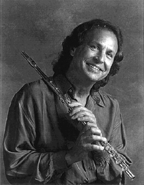(Read about this in the print copy of Jazz Now Magazine. Call 510-531-9249 or via e-mail at jazzinfo@jazznow.com.)
 The Kenny
Stahl Quartet at the Kuumbwa Jazz Center
The Kenny
Stahl Quartet at the Kuumbwa Jazz CenterSome people think Jazz flute is a neat special effect, a nice fluttery filler to stick in between the real instruments. Kenny Stahl thinks Jazz flute is an appropriate vehicle for solidly phrased lines, masterful solo statements that build, swing, and drive, and that produce a whole range of timbres, tones, colors, and moods - and by god he's right. Leave the elfish twitters for sprites, meadowlarks, and swinging shepherds. Stahl's respect for the instrument and his mastery of its solid (as opposed to vaporous or liquid) properties for sustaining meaningful dialogue over a range of Jazz idioms was impressively evident at his recent appearance at the Kuumbwa Jazz Center in Santa Cruz, California.
Stahl's quartet for the gig included five members, only one sign of the abundance of talent in this group. I'm guessing that the extra was Steve Robertson (not on the bill), whose adroit percussionism (on everything from congas to what looked like a pocket abacus) imparted a clean articulation to the rapid-fire program of Latin rhythms and straight-ahead Jazz standards and originals that would otherwise have been missed. The rest of the supportive configuration included pianist Murray Lowe, whose rich, multilayered solos emerged as some of the brightest moments of the evening, the powerhouse drummer Andy Weiss, and bassist Paul Henderson, who seemed most at home in straight-ahead Jazz territory. Stahl is a gracious performer, thanking the "select crowd" of the modestly filled Jazz club before regaling us with a bountiful and energetic set that we ate up likenot dessert, not the appetizer, butthe main course.
When it comes to Jazz flute, I'm hard to please. Okay, I kinda play it. But like most reviewers, I'm not one to let my rank amateurism as a musician stand in the way of my pickiness about real artists who really play "my" ax. Still, I have to say that Stahl brought my finely honed years of whining to a startled halt.
His clear, vibratoless tone and fearless claim of the lower and middle registers for establishing thematic statements made me want to stand up and salute. I was overjoyed by his sparing use of lip trills, overtones, and piercing high notes (all of which he can and does employ tastefully). The thing about effects is that they should be effective, right? Otherwise, what's the point? Stahl is the kind of player who uses a particular technique to make a point or he doesn't do it. He has an ear for the catchy phrase, and he'll let it groove awhile before punctuating it with fluidly cascading glissandos and superfast eruptions of tongued notes. His flautistry rests in the sublime balance between the flute as horn and the flute as percussion. His expressive attacks, often tongued, are sometimes placed at the early side of the beat, jabbing the combo with a lively "ride" punch that I'll bet some of you tenor sax nuts didn't know was possible; sometimes he bounces his notes fat and round in the center of the beat; and sometimes he strews them moodily bent and lagging ever-so-slightly behind, like sad, unanswerable questions.
Like the fare on his recent CD (Kenny's from Heaven, reviewed in Jazz Now in the May 1997 issue and available in the Jazz Now Direct CD Store on back coverof this issue), Kenny's repertoire at Kuumbwa mixed Jazz standards and originals, some with Latin rhythms. Stahl's own "Pixachuco" stands out in my mind for the sensitive interplay between Stahl and Lowe, the only side person at this live performance who was also on the CD. I liked the way Lowe approximated Stahl's multiple tonguing of the stuttering melody with a malletlike approach in his piano solo. Opportunities are abundant these days to catch Stahl in the Monterey area and the South Bay. Oh, yes, his mike technique is superbnone of that sputtery, breathy distortion you sometimes hear from a fluteand it turns out he was debuting his brand-new AKG. Keep it, Kenny! It's real nice.
by Sherrie Tucker